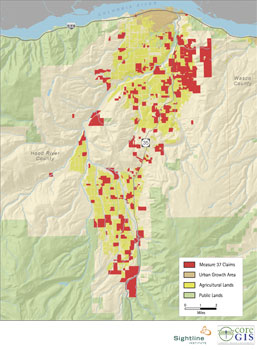The Hood River Valley has been ground zero for Measure 37 claims. Yesterday, we examined how the valley’s prized farm country is threatened by an exurban population boom. Today, we take a different look at how Measure 37 jeopardizes Hood River farmland.
In the map below, properties with active Measure 37 housing claims are showing in red. Yellow is land that’s zoned for agriculture.
Here, you can see all the new Measure 37 maps. And here, larger versions of this map.
While the Hood River country has astonishingly fertile soils, it’s a fairly small area. Less than 25,000 acres is protected farmland. But Measure 37 housing claims occur on 5,447 acres of farm properties—which adds up to 22 percent of the Hood River Valley’s agricultural land.
What’s wrong with houses on farmland? Simply put: the two don’t mix. It leads to inevitable conflicts that often spell the slow demise of farming. But don’t take my word for it, read what Gorham Blaine has to say. He’s a Hood River Valley pear farmer.
Thanks to CORE GIS for maps and analysis, and to Deric Gruen for the legwork.








